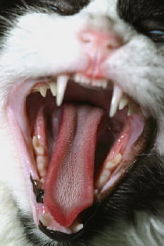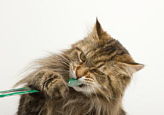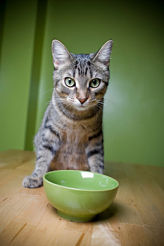Feline Mouth

This article is dealing with the feline mouth and not really going into detail on the tongue which is covered by the article named Cat Tongue. The anatomy, function and diseases associated with the cat’s mouth give clues to a cat’s overall health. The feline mouth is composed of the lips, gums, teeth, tongue and palate. The mouth aids the cat in eating, grooming, and hunting, carrying objects, protection and vocalizing.
Diseases and conditions that affect the oral cavity of a cat can affect normal functions. Changes in eating, drinking and grooming behaviors should alert an owner to a potential problem with the cat’s mouth. Some owners are hesitant to open their cat’s mouth for fear of hurting the cat or getting bitten.
Opening a cat’s mouth is normally not painful to the cat. It is a good technique to practice with a kitten. You will be able to observe the teeth, its oral health and administer medications once you get accustomed to performing this opening of the mouth task.
The feline mouth is lined with tissues called mucous membranes. The color of the mucous membranes can give clues to how well other parts of the body are functioning. Pale mucous membranes can indicate anemia, a low red blood cell count. Bluish tinged membranes can indicate poor oxygenation of the blood. Yellow membranes can indicate jaundice and liver disease.
All three of these different colors represent
potentially life threatening conditions if not properly treated. Vets
also use the mucous membranes as indications of an animal’s hydration
and circulation by touching and “blanching” the membranes and then
observing how quickly the color returns. Normally this capillary refill
time is less than two seconds.
There are two main inflammatory conditions found the feline mouth: plasma cell stomatitis and chronic feline gingivitis stomatitis.
Cats with these conditions have red, irregular areas present in their
mouths. Negative feline leukemia and feline immunodeficiency virus
tests and biopsy are necessary to distinguish between these conditions.
Both types of inflammation are managed but rarely cured.
Cats with advanced cases of these conditions experience extreme pain when opening their mouths. They have difficulty eating and cannot groom themselves. Treatments range from using antibiotics and anti-inflammatories, to removing pieces of mouth tissue, to full mouth dental extractions. The causes of these conditions are not fully understood.
Five viruses can cause oral lesions in cats. The respiratory infections caused by feline herpes and feline calici
viruses can cause small blisters which rupture and form ulcers on the
lips, gums, tongue and palate. These are not dissimilar to the fever
blisters caused by the human herpes virus. FIV positive cats often have
chronic gingivitis. Immunosuppression causes the chronic
gingivitis-stomatitis associated with some FeLV-positive cats. Panleukopenia, an uncommon virus, has been shown to cause oral ulcerations.
Drooling is not a normal characteristic of the feline mouth. A vet exam is
recommended for drooling cats. Only a few cats drool when they are
excited, nervous or happy. Most owners consider drooling an abnormal
feline behavior. Of course other things like foreign objects stuck in
the cat’s mouth, viral infections that cause oral ulcers and tumors of
the lips, gums or tongue can also cause drooling. If a cat licks a
bitter substance such as rubbing alcohol, or eats a bitter tasting item
such as a beetle, it might drool.
Cats that experience trauma or have broken jaws might drool. A common
trauma to the mouth occurs when a cat chews on an electrical cord and
burn is its mouth. Burns can be minor or severe. If severe damage is
present, the cat may be unable to eat or drink on its for weeks. The
same is true for jaw fractures. Wires, pins or muzzling may be needed
to stabilize the jaw.
If a growth is found in the oral cavity of an older cat, it might be a benign
or malignant tumor. Unlike other external growths, oral tumors can be
difficult to remove or treat. Tumors can appear on the lips, jaw bones,
gums or tongue. Squamous cell carcinoma, a malignancy, is the most common oral tumor. Non-cancerous masses found in the mouths of cats are gingival hyperplasia, dental abscessation and eosinophilic granuloma. A biopsy allows a vet to diagnose the type of mass.
Conditions that affect the palate and salivary glands in cats are not common. Cleft palate, a deformity where the roof of the mouth is not closed properly, can be surgically corrected. Salivary glands can be removed and the cat will still be able to function normally. Oral cavity damage or disease creates potential health problems if the cat’s ability to eat and drink is compromised.
Under normal conditions, it is
difficult to orally force a cat to eat or drink enough to maintain
itself adequately. Feeding tubes and fluid injections are methods used
to deliver proper nutrition and fluids to the cat. Vets place tubes
through various sites into the stomach allowing food to bypass the
mouth. Common types of tubes are those that go from the nose to the
stomach and those that go through the body wall directly into the
stomach. Tubes can be used to feed cats for months if necessary.
Administering fluids is possible through intravenous catheters or subcutaneous
injection. Owners can be trained to feed their cat though a tube and
inject their cat subcutaneously with fluids. It can be the difference
between recovery and death. Metabolic changes occur when a cat does not
eat for more than a day or two, and the resulting progression of events
can be more life threatening that the original problem.
Cats use their feline mouth to perform behaviors other than eating and drinking. A cat needs a healthy, pain-free mouth and a strong tongue to groom. Every cat spends a different amount of time grooming and some cats groom themselves, some groom other cats, and some even try to groom their owners.
Defensive behavior is also displayed by the feline mouth. A cat in a threatening situation may growl, hiss, spit or bite in order to defend itself. These behaviors are sometimes more show than action, but one never wants to underestimate a cat. Cat bites differ significantly from dog bites. A dog will bite, shake its head and tear the skin. Cats usually bite to puncture, and then let go. This injects bacteria deep into tissues where it can fester and cause infection. If you are bitten by a cat, you should consult your doctor and be treated with antibiotics.
Owners of outdoor cats know about the infection associated with cat fight wounds. Bite wounds are not always noticeable initially. After the bacteria have been under the skin for three or more days an abscess can form. To heal properly, an abscess needs surgical lancing and drainage. We’ve had this happen with Max Factor, who goes outside briefly, but gets into trouble once in a while.
The feline mouth is also used to cry, meow and talk to other cats. They lack the ability to move their lips to produce the wide variety of sounds that humans can but they have a pretty good repertoire. Cats are quite adept at using their mouths to carry things and queens use their mouths to carry and care for their kittens. Cats that are good hunters parade around with their prey, which they haven’t finished off, in their mouths. Some cats will fetch objects and carry them back in their mouths.
The feline mouth plays a role in numerous aspects a cat’s life. By observing
changes to your cat’s mouth and seeking veterinary advice when problems
are observed, you can help your cat stay healthy.
Related Articles......
Return from Feline Mouth to Cat Health Detective Homepage
Having trouble finding what you need? Cat Health Index & Site Map
OR
Do you have a question to ask?...Questions
OR
Do you have a cat story to share?...Simply click here to go to that page!
Copyright@2010-2020 All rights reserved.Cat-health-detective.com
This website is information only. Consult a veterinarian for medical assistance

"Like Us" on Facebook
or...
"Like Us" here




















